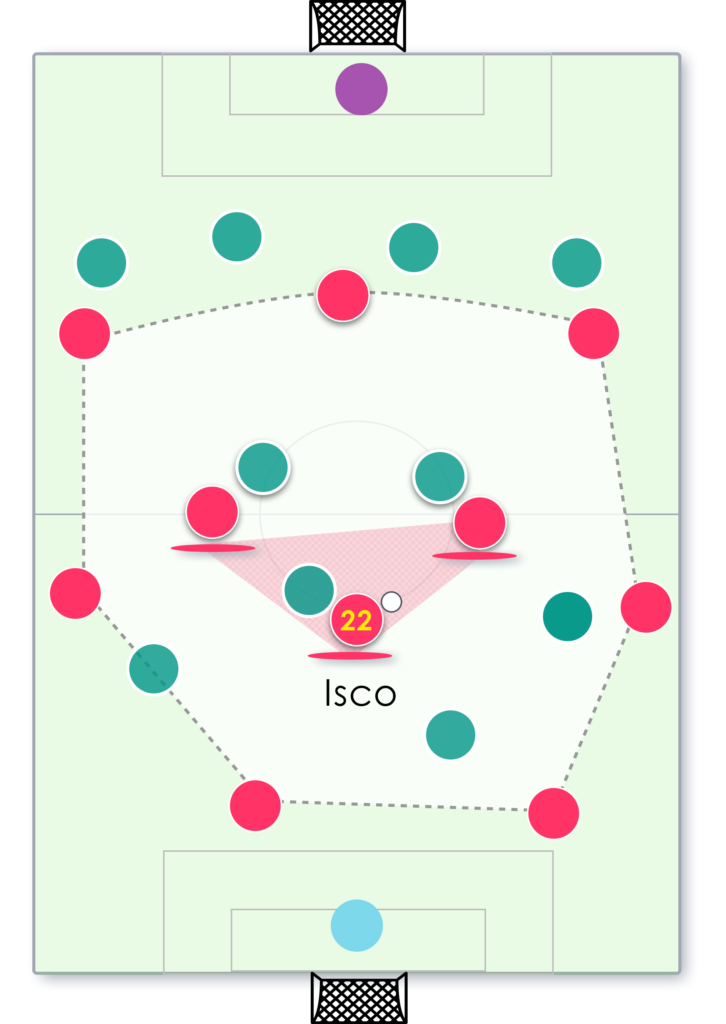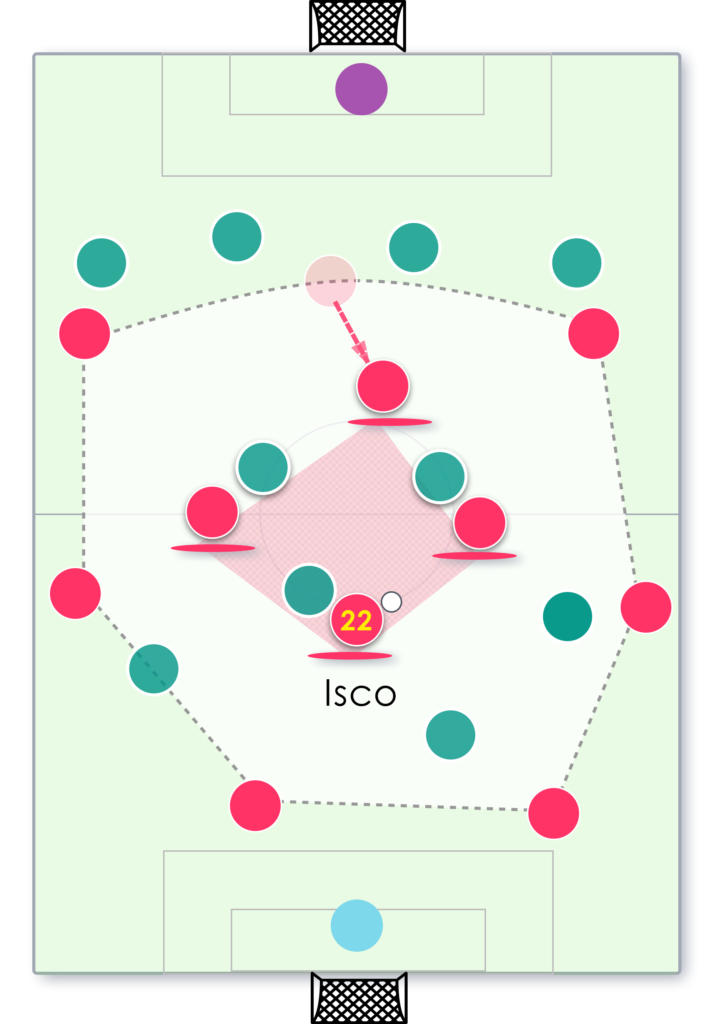Overview
This post was written in 2018 and presents an initial reflection on positional fluidity and its growing role in the upcoming years. It presents a new way of thinking about the game, with 7 players outside and 3 players inside, who adjust their positions based on the demands of the game. This approach complements the current view of football and could bring significant changes to the game.
Moreover, this new approach has implications for how teams should be trained and players should be developed. It is necessary to develop skills that can generate superiorities beyond just numerical advantages, such as positional and qualitative advantages. This shift highlights the importance of deepening our understanding of what a “good pass” means in football and how it can be used to create these advantages.
The post is supported by the Spain v Germany friendly match played in March 2018. The Spanish National Team represents the future of football and their innovative movements and patterns on the pitch are expected to become more commonplace in the coming years.
Before starting, watch this video.
1
The “Exhaustion” of Numerical Superiority.
Josep Guardiola revolutionized football. In addition to his titles, he established a way of thinking about the game that had been explored and used before, but never before in such a systematic, consistent, and interconnected way. As a result, he caused a significant shift in how the game is perceived.
At the heart of his approach is the idea of numerical superiority, which taken to an extreme follows this storyline:
- When my team has the ball, we initially organize ourselves in a 4-3-3 formation for various reasons, such as width, depth, and different shapes that are useful and easier to achieve.
- My opponent will try to neutralize us but will leave one extra defender at the back to balance the risk, resulting in 4 defenders against 3 forwards.
- As a consequence, we will have an extra player somewhere else on the pitch. Although we don’t know exactly where this player will be, we know he/she will be there. This player is called the free man.
- The idea is then to exploit this numerical advantage across the pitch, supported by other football concepts such as width, depth, and third man, until we reach the final third. From there, players will have the freedom to look for the target.
- The space we need to pursue “is” the free man, and the team’s mission is to move the ball intentionally to find and progress with the free man.
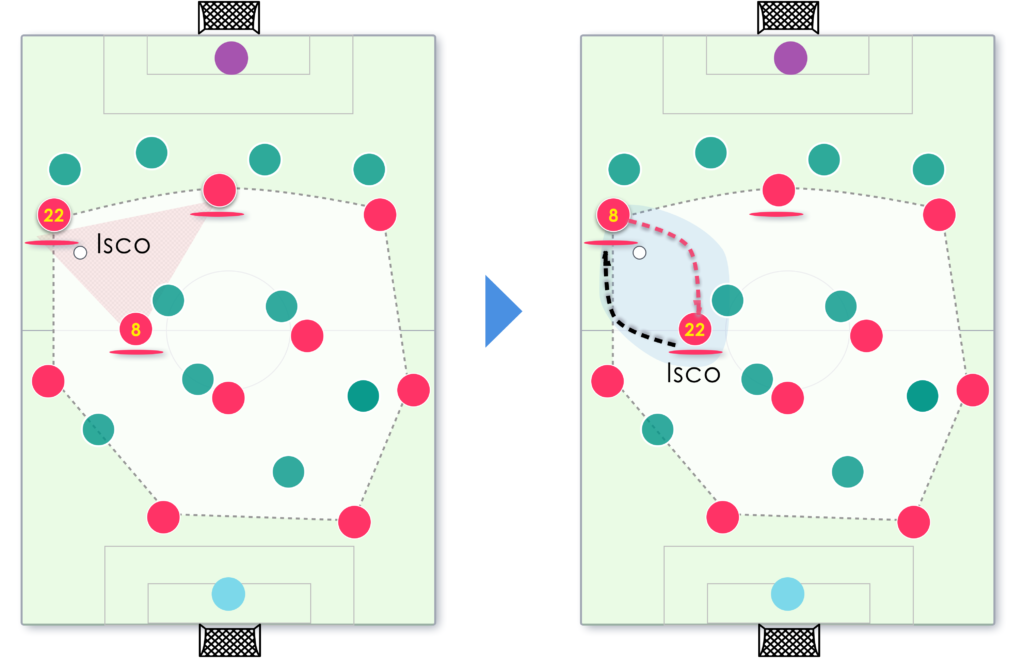
Positional Fluidity means that a player can play well in different spaces and take different roles, with the ultimate objective of harming the opponent.
Around this oversimplified story, a big chunk of the paradigm of the modern game grew over the last decade, especially the Juego de Posición, with many improvements and new discoveries at the tactical and methodological levels, resulting in an overall increase in the quality of the game. However, at some point, everything needs to be recycled and refreshed. We are now approaching a tipping point where more complexity is necessary to become successful (or more simplicity, depending on how one wants to look at it).
We are approaching an Era where the starting point will stop being to assume that we need to find the free man to progress on the field.
The starting point is becoming gradually less often to assume that to find the free man suffices to progress on the field. The game now requires to leverage other resources, in particular to exploit other types of superiorities (positional, qualitative and socio-affective). Key spaces are now being discovered and offset more often, the free man is intentionally chosen by the opponent so that it appears in low-risk areas. The ideal space is no longer necessarily where the free man is. And with that, players need to make more unconventional movements to generate the spaces.
In particular, the Spain National Team represents the football of the future (or of the past): one with more positional fluidity.
2
Positional Fluidity: To do what the game demands
Positional Fluidity refers to the ability of each player to play effectively in different areas of the field and perform various roles, with the ultimate aim of causing confusion to the opponent and gaining an advantage. The specific space and role that a player takes on is determined primarily by what the game demands in a given moment, rather than being predetermined beforehand.
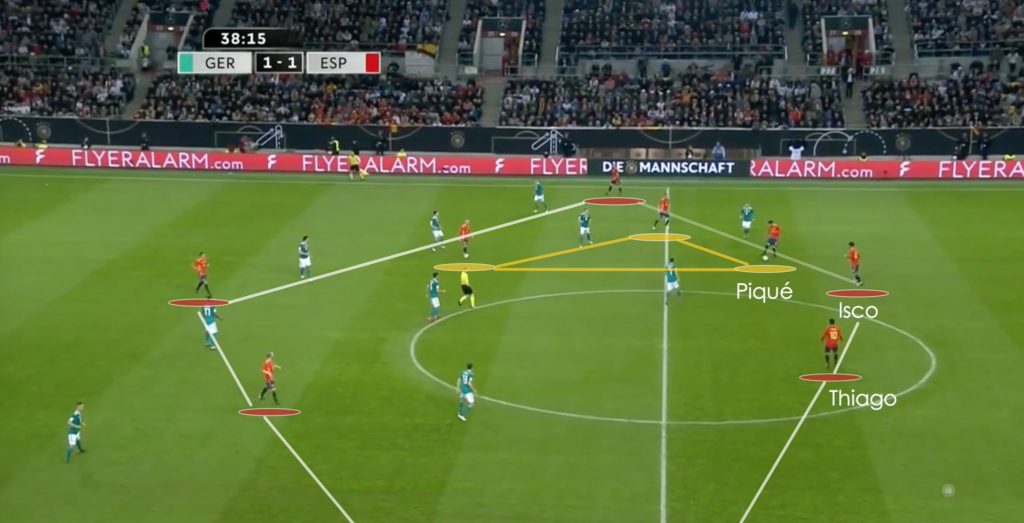
Piqué in. Isco and Thiago get out to balance the Core Structure. It disorganizes the opponent and, well used, allows to find free spaces.
The term “position” is no longer a static label for each player (e.g. “I play as a winger”), but instead is now a dynamic function of what the game demands based on the opponent’s defensive structure. For instance, a left winger may have predetermined movements for their position, and there are certain areas of the field that they would not normally occupy. However, taking this idea to the extreme, why can’t a left winger play as a right back in certain moments? Why should we continue to define players solely by their fixed positions?
With more positional fluidity, players can gain valuable seconds and open up spaces against opponents, who will inevitably have to respond and react sequentially. This makes it more difficult for defenders to maintain the reaction speed needed to avoid the attack. Players who constantly interchange positions and move in and out of zones can generate disconnection among defenders on how to solve certain situations. The result is the opportunity to win necessary time to progress on the field, not necessarily through numerical superiority.
3
Think the game with 7 outside and 3 inside
One of the ways in which it looks the game is moving forward towards this is by seeing the situation as one where there are 7 players “outside” and 3 players “inside”. Or 6 outside, 4 inside, depending on whether the “center-forward” moves back to the center. The idea of 7 players “outside” and 3 players “inside” is just one example of how this positional fluidity can work in practice.
Players outside continue to provide the necessary width and depth to generate enough space to move the ball. Players inside control the speed at which the team moves forward (in Pep´s terms, they control the game).
Depending on where they detect the opportunity is, some get into the center, others get out. Or some get in temporarily to take advantage of superiorities they can detect. At any given moment, each player occupies the closest space based on the Core Structure (rather than a fixed position).
Why think in these “7 outside – 3 inside” terms?
- Because a structure will continue to exist. It’s not about generating chaos but about creating more resources to damage the opponent.
- Because this Core Structure continues to foster certain desired principles needed to damage opponent (width and depth to generate enough space, etc). Numerical superiority will still be an option (mostly the first option, if possible), but a game where some get in and some others move outside provides with more resources to damage.
4
Impact in Methodology: Positional Superiority.
The main methodological implications of assuming this new reality mean that:
- A player will need to know how to play both outside and inside.
- Tactics set up towards trying to find the free man as the main way to move forward on the field needs to be complemented with bringing more awareness around which way a team can exploit other superiorities (in this case, positional and qualitative) by opening up spaces through more movement of all the players.
I will leave it for another time more detailed, structured and specific aspects around how to train fluidity. In the meantime, what follows are two ideas which deserve attention:
a) Rondos with no numerical superiority in the center.
These two pictures represent two very basic Rondos but with very powerful implications: the first one is a 4v2, where numerical superiority comes by default, and where the idea is to generate the conditions to exploit this superiority. These types of situations (and all the different, more complex variants) have had an enormous contribution in helping players understand something that today sounds very basic: Where the free man is.
The second one, on the other hand, has no numerical superiority in the center. It is a 2v2 inside, with joker/neutral players outside, the most simplified version of “some outside, some inside”. Who are inside will need to use other resources to solve the problem. This is what´s happening in elite football. The player needs to be able to solve problems using sprints, protect the ball, dribble. And, of course, lots of movement.
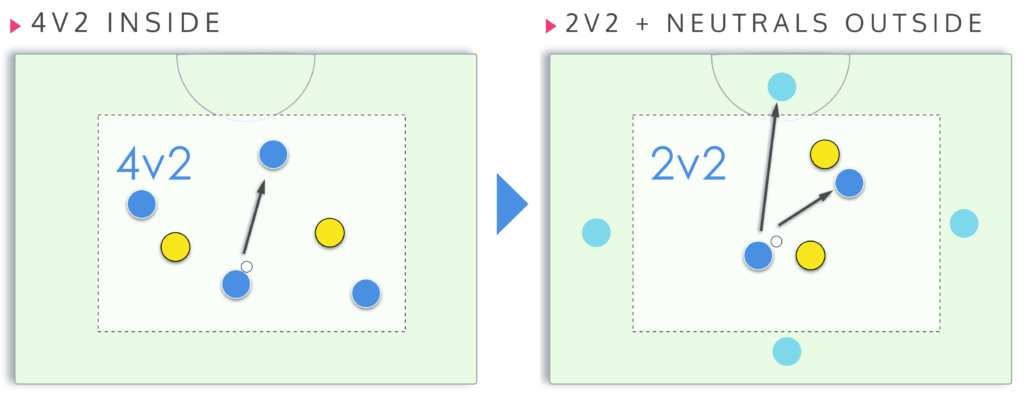
In the last decade, it has been more common to find Rondos born from the structure on the left, that implicitly assumes that the solution comes just from finding the free man somewhere.
This suggests that it will become more important to put more weight to the second types of Rondos (with no numerical superiority, at least inside), as the type of game played in the center has new demands.
Rodolfo de Paoli, in his YouTube Channel (in Spanish), calls this “juego de ubicación” (or “location game”), and his core exercise for training this can be found in this short video:
b) Increase the level of conversation around passing.
The quality of the pass matters a lot. And if it matters a lot, it cannot NOT be in the youth development programs as a core aspect. But I am not talking about the technique of the pass; I´m talking about all the information that can be sent through a pass.
In this post (Spanish only for the time being) I suggest that the next move comes implicitly in a pass. Under situations where the game will demand players to beat opponents positionally (and not necessarily in number), a pass is what connects the ideal space with the ideal time. In a pass can come the problem already solved.
More than ever, technique and tactical intention should go hand in hand, and to split them is very dangerous. As a consequence, speed, time and direction chosen for a pass should have exactly the same importance at any conversation (for example, a correction or analysis) as the execution has.
Ex Google | Real Madrid Youth Academy (Tactical Analyst & Administration of Academy) | Master in Talent Development in Football (Escuela de Real Madrid)| Certified Coach (Argentina & Federación Catalana de Fútbol) | Follow me on Twitter & LinkedIn (@juliangenoud). Escribime a juliangenoud-at-gmail.com
